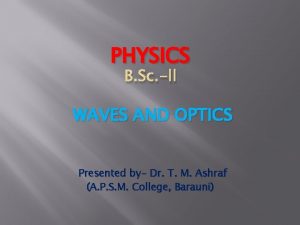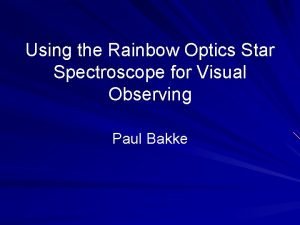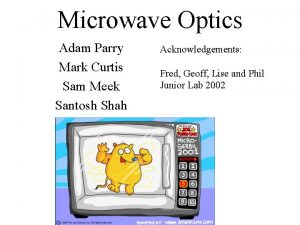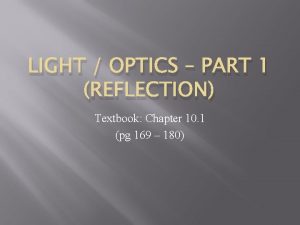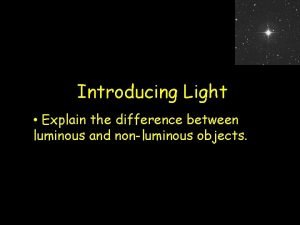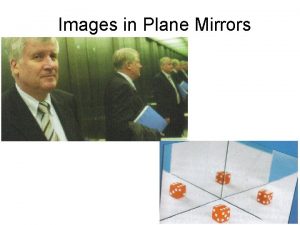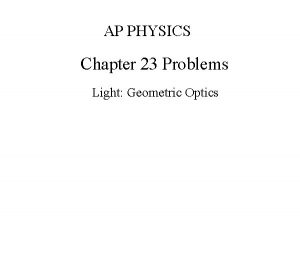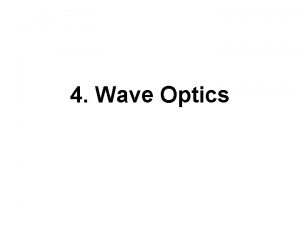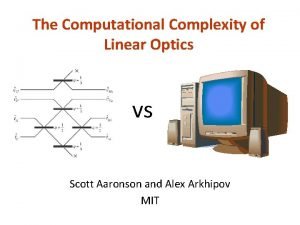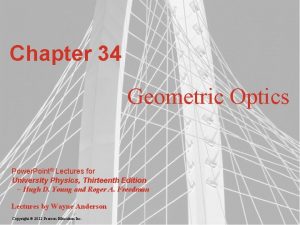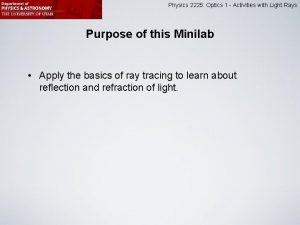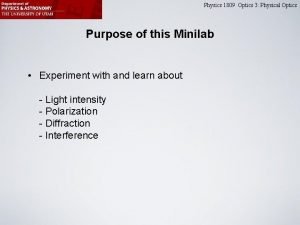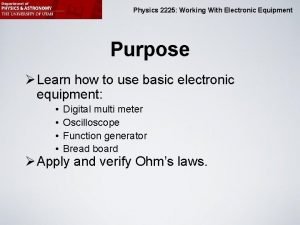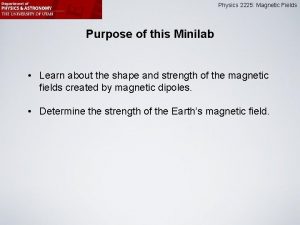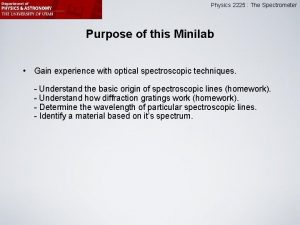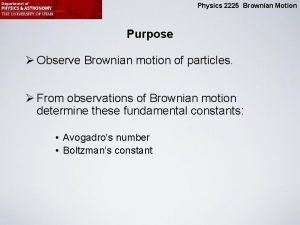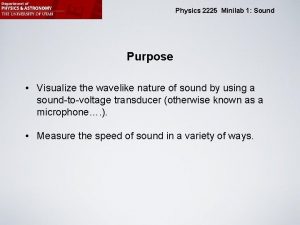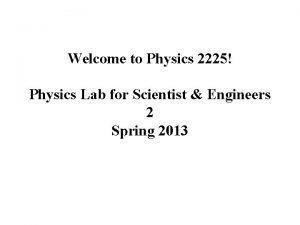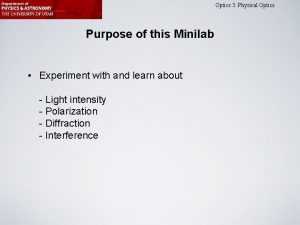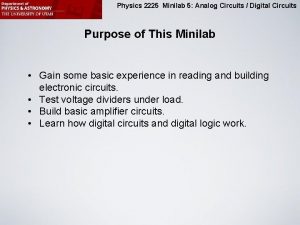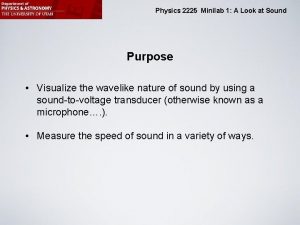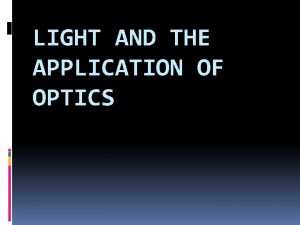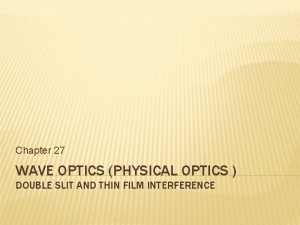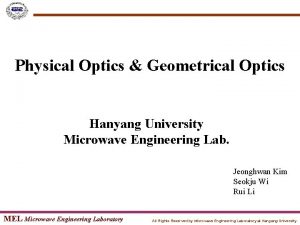Physics 2225 Optics 3 Physical Optics Purpose of




































- Slides: 36

Physics 2225 Optics 3: Physical Optics Purpose of this Minilab • Experiment with and learn about - Light intensity - Polarization - Diffraction - Interference

Physics 2225 Optics 3: Physical Optics WARNING – Lasers Used in this Lab Lasers can cause permanent damage to the eye. Do not look directly into the laser beam!!! Do not aim the laser towards others!!!

Physics 2225 Optics 3: Physical Optics Activity 1: Light Intensity Light (and other electromagnetic radiation) carries energy.

Physics 2225 Optics 3: Physical Optics Activity 1: Light Intensity Example: The Sun The sun radiates 4 x 1026 Joules of energy every second. The sun is 1. 5 x 1011 m (93. 2 million miles) away from the earth. What is the intensity of solar radiation on the solar panel of a satellite?

Physics 2225 Optics 3: Physical Optics Activity 1: Light Intensity Earth with satellite (they both are about the same distance from the sun). R All the solar power must pass through a virtual sphere (with the earth at the surface of that sphere). The power from the sun is spread out over the surface area of that sphere (4 p. R 2). Note: Due to reflection at the earth’s atmosphere only 250 W/m 2 arrive at the earth’s surface.

Physics 2225 Optics 3: Physical Optics Activity 1: Light Intensity Photometer: Compares the light intensities entering the two side windows. Side windows Look through the eyepiece in the center: Unequal color in the two half circles indicates different light intensities.

Physics 2225 Optics 3: Physical Optics Activity 1: Light Intensity Equal colors in the two half circles indicates equal light intensities.

Physics 2225 Optics 3: Physical Optics Activity 1: Light Intensity You can attach a variable filter disk to one side to vary the intensity on that side. 4 different filters are available: 100%, 75%, 50%, and 25% (% indicates the amount of light transmitted by the filter).

Physics 2225 Optics 3: Physical Optics Activity 1: Light Intensity 1. 1 Measure how the light intensity changes as the light source is placed further and further away. Pasco light source Point source (hole) on this side Photometer filters Optics mounts (empty lens holders) Flash Light Optics Bench Leave some room (maybe 10 cm) between filter and flash light

Physics 2225 Optics 3: Physical Optics Activity 1: Light Intensity Optics Bench r Procedure for Activity 1. 1: 1. 2. 3. 4. 5. 6. 7. Rotate filter to 100% I 0 setting ( = no filtering). Move point source such that photometer shows even color. Record distance r. Rotate filter to 75% I 0 setting. Move point source such that photometer shows even color. Record distance r. Etc. . I (arb. units) r 1 0. 75 0. 50 0. 25 … … r 2 … … I I r r 2

Physics 2225 Optics 3: Physical Optics Activity 1: Light Intensity Question 1: What is the relationship between intensity and distance from a point source? Hint: Think about the example we gave with the sun.

Physics 2225 Optics 3: Physical Optics Activity 1: Light Intensity 1. 2 Measure how much light intensity is transmitted by a polarizer. Add a polarizer. Pasco light source Point source (hole) on this side Photometer Filters (Don’t change distance of flash light to photometer) Optics Bench r 1. 2. 3. 4. 5. Insert a polarizer between photometer and flash light (but do not change the distance between photometer and flash light). Select 100% filter. Move the Pasco light source until photometer shows equal intensity. Record distance r. Use I versus r (or I versus r 2) table to determine what I is with polarizer inserted. .

Physics 2225 Optics 3: Physical Optics Activity 2: Polarization y Light has wave characteristics. Electric field vectors a short time later x Direction of propagation z Electric field vectors

Physics 2225 Optics 3: Physical Optics Activity 2: Polarization Now looking at the electric field vector at one particular point in space in the direction of propagation (light travels “into the screen”): y y a little later t=0 E x even later x E x y E even later Let’s symbolize it as: x Etc…. goes up and down x This light is called “linearly polarized” (in the y-direction). y y E

Physics 2225 Optics 3: Physical Optics Activity 2: Polarization x Linearly polarized in the y-direction y y y x Linearly polarized in the x-direction x Unpolarized light (a superposition of many “light waves” that are polarized in a random direction).

Physics 2225 Optics 3: Physical Optics Activity 2: Polarization A polarizer (often that is a thin sheet of material) only passes light that is polarized in a certain direction: Indicates polarizer orientation. Polarizer x Light before passing through the polarizer. y y y x x Light after passing through the polarizer (no change).

Physics 2225 Optics 3: Physical Optics Activity 2: Polarization Polarizer x Light before passing through the polarizer. y y y x x All the light is blocked by the polarizer.

Physics 2225 Optics 3: Physical Optics Activity 2: Polarization Polarizer x Light before passing through the polarizer. y y y x x Only the component of that is aligned with the polarizer passes. Reduced intensity Changed direction of polarization.

Physics 2225 Optics 3: Physical Optics Activity 2: Polarization y y y x x x E cos (Q) E = y y + x x (vector addition) E cos (Q) E sin (Q)

Physics 2225 Optics 3: Physical Optics Activity 2: Polarization …and this is why it’s called a “polarizer” Polarizer x Unpolarized light before passing through the polarizer. y y y x x After the light passes through the polarizer: Light is polarized.

Physics 2225 Optics 3: Physical Optics Activity 2: Polarization 2. 1 Rotate polarizers with respect to each other and observe the intensity of the light after passing through both polarizers. Polarizers eye Optics Bench Answer Questions 4 and 5.

Physics 2225 Optics 3: Physical Optics Activity 2: Polarization 2. 2 Measure intensity I versus Q, where Q is the relative angle between the two polarizer orientations. Pasco light source Point source (hole) on this side Photometer Polarizers Filters Optics Bench Here’s an idea on how to do 2. 2 (feel free to improvise otherwise): 1. 2. 3. 4. Insert two polarizers between photometer and flash light. Align the two polarizer orientations so they are the same Put the filter on the side facing the Pasco light source and select the 100% filter. Move the Pasco light source until photometer shows equal intensity.

Physics 2225 Optics 3: Physical Optics Activity 2: Polarization 2. 2 Measure intensity I versus Q, where is the relative angle between the two polarizer orientations. Pasco light source Point source (hole) on this side Photometer Polarizer 2 Polarizer 1 Filters Optics Bench 4. 5. 6. 7. 8. 9. 10. Select the 75% filter. Slowly rotate polarizer 2 while observing the photometer. Find and record all orientations Q of polarizer 2 for which you see equal intensity. Repeat steps 4 -6 for the 50% and 25% filters. Create a table with two columns: Q and intensity. Create a graph of intensity versus Q. Try other plots (e. g. intensity versus cos(Q) or versus cos 2(Q)…etc. ) to try to find the relationship between angle and intensity.

Physics 2225 Optics 3: Physical Optics Activity 3: Diffraction and Interference Shining coherent light (e. g. , laser) through a small slit (or multiple slits) causes interference (a fancy word for “wave addition”) of the “light waves”. Wave fronts of light Dark screen Double slit The wave going through this slit has to travel just a bit further to get to this particular place on the screen. The waves from the two slits are out of phase by half a wavelength. The two waves annihilate each other. (“destructive interference”). There will be darkness on that place on the screen.

Physics 2225 Optics 3: Physical Optics Activity 3: Diffraction and Interference Dark Bright The waves going through both slits travel the same distance to the screen. The waves from the two slits are in phase. The two waves add together and have twice the amplitude (“constructive interference”). There will be a bright spot on that place on the screen.

Physics 2225 Optics 3: Physical Optics Activity 3: Diffraction and Interference Dark The light exits the slits in all directions simultaneously. A pattern of bright and dark spots appears. (called “Interference pattern”). Bright Dark

Physics 2225 Optics 3: Physical Optics Activity 3: Diffraction and Interference The pattern of interference depends on the slit sizes, slit number, and slit separation, etc. . Single slit a (slit width) Double slit a Multiple slits d: separation between slits 3. 1 Look at interference patterns of: 1) Single slits (use different slit widths) (Q 7). 2) Double slits (use different slit separations) (Q 8). 3) Multiple slits (keep a and d constant and vary number of slits) (Q 9).

Physics 2225 Optics 3: Physical Optics Activity 3: Diffraction and Interference Laser Disk with different slit patterns (rotate to select). Laser light Optics Bench Laser power supply Screen

Physics 2225 Optics 3: Physical Optics Activity 3: Diffraction and Interference Hint for Question 10: For a double slit there is not only interference between the two slits but also within each slit (each slit has its own single slit interference). Think of superposition of two effects.

Physics 2225 Optics 3: Physical Optics Activity 3: Diffraction and Interference 3. 2 Determine the wavelength of the laser light. 2 nd order maximum (m=2) Bright Dark 1 st order maximum (m=1) y (for m=1) 0 th order maximum (m=0) D Bright Dark 1 st order maximum (m=1) Bright Dark 2 nd order maximum (m=2) multi slit Bright

Physics 2225 Optics 3: Physical Optics Activity 3: Diffraction and Interference Bright Dark 1 st order maximum (m=1) Bright Dark Hint: It is more accurate to measure 2 y and then divide by 2. 2 y (for m=1) Bright Dark 1 st order maximum (m=1) Bright Dark Bright

Physics 2225 Optics 3: Physical Optics Activity 3: Diffraction and Interference 3. 3 Determine the distance d between the “grooves” of a CD d

Physics 2225 Optics 3: Physical Optics Activity 3: Diffraction and Interference Method: Reflection on grooves produces also interference pattern. Dark Bright CD (with grooves) reflected light Dark Bright screen Dark Laser Bright Dark screen behind laser D

Physics 2225 Optics 3: Physical Optics Activity 3: Diffraction and Interference Optics mount Screen CD attached Laser light Laser Optics Bench 10 cm

Physics 2225 Optics 3: Physical Optics Activity 3: Diffraction and Interference Again: Use to determine d. Question 15: How many grooves are on the CD? Yes, technically there is only 1 groove on the CD that snakes its way from the outside to the center. The proper question you should answer is: How many times does this groove go around the CD?

Physics 2225 Optics 3: Physical Optics Using the Desk Lamp Plug (black) must be plugged into dimmer plug. Dimmer plug (white) must be plugged into power outlet. Dimmer On/Off switch of lamp
 Reflection and refraction venn diagram
Reflection and refraction venn diagram Lucas 8 22-25 explicacion
Lucas 8 22-25 explicacion Difference between ray optics and wave optics
Difference between ray optics and wave optics Wave optics b.sc physics
Wave optics b.sc physics Modern physics vs classical physics
Modern physics vs classical physics University physics with modern physics fifteenth edition
University physics with modern physics fifteenth edition Physics ia exemplars
Physics ia exemplars Purpose purpose
Purpose purpose General purpose specific purpose central idea
General purpose specific purpose central idea Base and derived quantities
Base and derived quantities Osi physical layer
Osi physical layer What is the basic purpose of the osi physical layer
What is the basic purpose of the osi physical layer Rainbow optics star spectroscope
Rainbow optics star spectroscope Gestaltism
Gestaltism Turba optics
Turba optics Types of optics
Types of optics Curtis parry
Curtis parry Single ray
Single ray Grade 10 optics review
Grade 10 optics review Physics 241 purdue
Physics 241 purdue What is the difference between luminous and non luminous
What is the difference between luminous and non luminous Properties of plane mirrors
Properties of plane mirrors Hotwire fiber optics
Hotwire fiber optics Http //www.phys.hawaii.edu/ teb/optics/java/slitdiffr/
Http //www.phys.hawaii.edu/ teb/optics/java/slitdiffr/ Http //www.phys.hawaii.edu/ teb/optics/java/slitdiffr/
Http //www.phys.hawaii.edu/ teb/optics/java/slitdiffr/ Types of optics
Types of optics Optics
Optics Fourier optics
Fourier optics Vergence formula optics
Vergence formula optics The computational complexity of linear optics
The computational complexity of linear optics Write snell's law
Write snell's law Bill nye light optics
Bill nye light optics Introduction to fiber optics
Introduction to fiber optics Cauchy formula optics
Cauchy formula optics Adaptive optics
Adaptive optics What is optics
What is optics Geometric optics ppt
Geometric optics ppt



